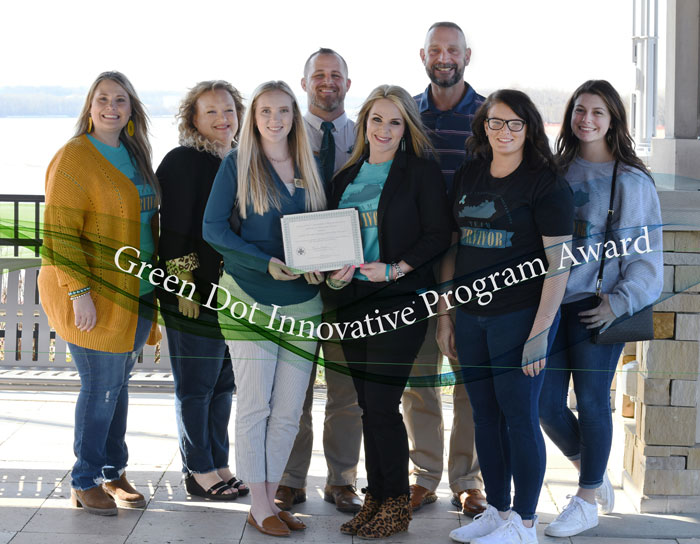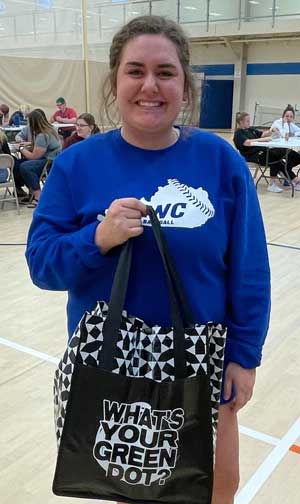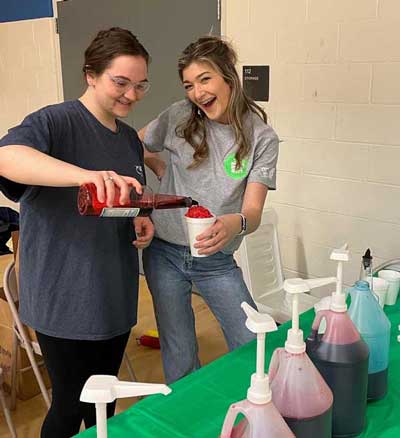
What is Green Dot?
Picture a campus map. Every time an instance of sexual assault, dating violence or stalking takes place, a red dot appears on the map. A red dot is a single choice to bring harm to another. This could be a threat, a hit, an unwanted touch or unwelcome comment. Lindsey Wilson College does not tolerate sexual assault, dating violence or stalking, so what can we do to prevent these red dots from appearing on our campus? By placing green dots on the map instead, which represent every time an individual does something to prevent sexual assault, dating violence or stalking from happening. A green dot is any choice that promotes safety and communicates intolerance for violence. A green dot is getting someone else involved, creating a distraction to defuse the situation, checking on the person being harmed or asking someone to step back. Power-based personal violence is not a solid mass that can be removed with one swift action or policy; rather, it is the accumulation of individual choices. The Green Dot program plays a key role as part of a comprehensive strategy to reduce rates of violence and empower all members of a given community. Through Green Dot bystander training provided by trained LWC staff, the Green Dot program trains witnesses to interrupt situations that are high-risk for violence. The program also increases self-efficacy and provides skill building and specific strategies to increase the likelihood that trained individuals will actually intervene. By expanding the role of bystanders beyond reactors, the Green Dot program trains participants to engage in proactive behaviors and norms that are incompatible with violence, thus preventing red dots from occurring. The ultimate goal is not simply to react to potential violence as it is occurring, but rather to simultaneously shift community norms that support the violence that is occurring.Green Dot Strategy + Research
Traditional prevention programs may only approach men as potential perpetrators and women as potential victims. Green Dot approaches all students, staff, administrators, and faculty as allies. The original Green Dot program was conceived in the college setting to prevent dating violence, sexual violence, and stalking. It relies on the premise that if everyone does their small part and commits to individual responsibility, the combined effect is a safe campus culture that is intolerant of violence. The college-based curriculum draws heavily on the experiences of college students and the reality of this issue in their lives. This curriculum uses interactive activities to reinforce core concepts and encourages students to envision their future and the world in which they want to live, then aligns their bystander behavior with that vision.Why Green Dot?
- A CDC review of 140 studies evaluating violence prevention programs (DeGue et al., 2014) and a review of evaluations conducted since the 2014 review shows that Green Dot is the only prevention approach that has been shown to reduce multiple forms of interpersonal violence.
- Four evaluations of Green Dot have been conducted with college and high school students and all have found positive results.
- Green Dot has been used in 300+ colleges, 50+ high schools and middle schools, 50+ communities, installations from all branches of the military, is being piloted in the construction trades and other workplaces, and is being implemented on four continents.
- Green Dot has been selected as the prevention strategy for sexual assault, stalking, and domestic violence for the United States Air Force.
What’s YOUR green dot?
Green Dots For Anyone
- Change your e-mail signature line to include the statement, “Live the Green Dot” and include the link to our Green Dot website.
- Donate to a local rape crisis center or domestic violence shelter and write “Green Dot Supporter” in the memo line.
- Hang one of our Green Dot posters on your room or office door.
- Hang one of our “I’m Green Dot Trained” placards on your door.
- Put a link to campus or community resources on any website you have access to.
- Send a mass e-mail to your contact list with a simple message like, “This issue is important to me and I believe in the goal of reducing violence on campus.”
- Next time you are walking to class with a friend or taking a lunch break with a co-worker, have one conversation about Green Dot and tell your friend that ending violence matters to you.
- Add the phrase “Ending violence one Green Dot at a time” to your Facebook or Twitter account.
- Make one announcement to one group or organization you are involved in, telling them about Green Dot.
- Write a paper or do a class assignment on violence prevention.
- Wear a Green Dot button and be willing to explain Green Dot to anyone who asks.

Green Dotsots For Students
- Tell a friend of yours that ending violence is important to you.
- Add the phrase “Green Dot Supporter” to your Facebook, Twitter, or Instagram profiles.
- Using email, text, Facebook, Twitter, Instagram, or Snapchat – send a mass message out to all of your friends that violence prevention matters to you, and give them the link to campus or community resources.
- Volunteer at the Sexual Assault Resource Center or Phoebe’s Home.
- If you are concerned that a friend of yours might be a victim of violence, gently ask if you can help and respect their answer.
- Attend a program or event designed to raise awareness about violence.
- Create a fund-raiser for a campus or community organization that works to address violence.
- Look out for friends at parties or where alcohol is involved to ensure everyone arrives and leaves together.
- Work to bring an education program to your class or group.
- Hang a Green Dot poster on your door.
- Hang an “I’m Green Dot Trained” placard on your door.
Green Dots For Athletes
- Like our Facebook, Twitter, and Instagram pages to keep up to date on what’s happening on campus.
- Talk to your coach about having a Green Dot training or overview speech for your team.
- If your whole team can’t attend a training, come to one of the open bystander trainings offered throughout the year.
- Talk to your coach about hosting a “Green Dot Game” to promote awareness about power-based personal violence and show your team’s commitment to ending it.
- Talk to your coach about adding a Green Dot to your uniforms to show your team’s commitment to ending violence.
- Watch out for your teammates at parties and bars.
Green Dots For Staff/Administrators/Faculty
- Recognize risk factors associated with violence and ensure that faculty, staff, and students are provided with adequate training to respond.
- Ensure adequate funding for prevention and intervention efforts.
- Talk with colleagues about your personal commitment to violence prevention and Green Dot.
- Integrate references to the Green Dot initiative and the importance of violence prevention into speeches and public addresses.
- Educate yourself and your staff about sexual violence, partner violence, stalking and abuse.
- Bring Green Dot training to your next staff meeting, organization meeting or retreat.
- Ensure that you have effective policies in place to assure safety in the workplace and support victims of violence.
-
Show your support
- Wear a Green Dot pin or another pin or piece of clothing (could even be a coffee mug that you carry) that has a message of anti-violence. Sometimes just showing your support and commitment can make a big difference.
- Place a Green Dot on your office door so students know you support prevention and their efforts as bystanders.
- Hang a Green Dot poster in your office or classroom.
- Have local resources’ brochures visibly available in your office and/or classroom.
- Insert a related statement on your syllabus
- Have an endorsement statement of some kind attached to your email signature line, such as “I’m a green dot supporter.” or “What’s your green dot?”
- Have link to your local service providers’ websites on all the web pages over which you have influence. (See the bottom of the page for local resources.)
- Three times per semester, simply ask your classes “What green dots have you done or seen lately?” Research tells us that this simple task provides significant reinforcement of green dot behaviors.
- Role model respectful language, compassion toward survivors, approach-ability, and looking out for others.
- Ask your department head or supervisor to bring a bystander training to your whole department.
- Have a conversation with your colleagues and students about what they can be doing to spread green dots.
- Where appropriate, bring educational programming on interpersonal violence to your classes.
- Where appropriate, include topics in your classes that address prevention and intervention of partner violence, sexual assault, stalking and bullying.
- Make it clear to your students that if they are dealing with violence, you are a safe person to approach for support and referrals.
- Become familiar with campus and community resources, and make referrals if needed.
- Consider conducting research that furthers our understanding of violence prevention.
- Assign readings or papers or journal topics on the issue of power-based personal violence.
- Build positive, trusting relationships with students; particularly those who may be experiencing violence or other adversities outside of class.
- Use your relationships and departmental or interdepartmental partnerships to discuss ways in which to support students as bystanders, support survivors, and improve safety for positive outcomes in the classroom.
- Create an opportunity to share your own experience as a bystander and how it made you feel, then and now. Or, you may have had a situation when you were at risk and someone did or didn’t help. You may have been in a situation where you saw something and did or didn’t help. Sharing your own experience will help your students process their experiences and become more active bystanders.
- The choices you make matter.
- You’re not a bad person because you don’t always get involved.
- There are a lot of options. You don’t have to do something directly. It’s best to pick the option that is best for you, depending on the situation and what’s coming up for you.
- What makes it hard for you?
- This is what makes it hard for me…
- What are ways of intervening that feel realistic to you?

Collaborate
Share your own experience
Talk to your students about being active bystanders. Talking points for student bystanders:
How to Participate
Green Dot Overview
The Green Dot Overview is a short talk (typically an hour) that introduces the key ingredients of bystander intervention while using persuasive and inspirational language to engage participants in immediate action. This talk is used to mobilize members of any given community to bystander engagement, generate community-wide buy-in, and begin the process of behavioral change.Green Dot Bystander Training
The Green Dot Bystander Training is an interactive training designed to mobilize a community by equipping participants with the necessary connection, knowledge and skill to increase their proactive and reactive bystander behaviors. The length of the training is 2-3 hours. In-depth discussions and exercises are utilized throughout the training to maximize the level of engagement of participants and help them apply the concepts in the curriculum to their own lives. If you are interested in participating in a Green Dot Overview or Bystander Training, please submit your email below.I want Training
Resources
Adanta Sexual Assault Resource Center
Crisis Line: 1-800-633-5599
130 Southern School RoadSomerset, KY 42501
606-679-4782 ext. 2372
www.adanta.org
Help for Survivors; Kentucky Association of Sexual Assault Programs
https://www.kasap.org/help-for-survivorsKentucky United against Violence Shelter Programs
https://www.zerov.org/shelter_programsRAINN (Rape, Abuse & Incest National Network)
https://www.rainn.org/National Sexual Assault Hotline
Call 800-656-HOPE (4673)Lindsey Wilson College Public Safety
270-384-8106If campus phone lines are inoperative, Public Safety & Security can be reached directly by dialing 270-634-1147 (mobile or text).
TJ Health Columbia
901 Westlake DriveColumbia, KY, 42728
270-384-4753